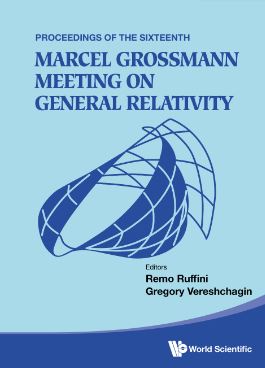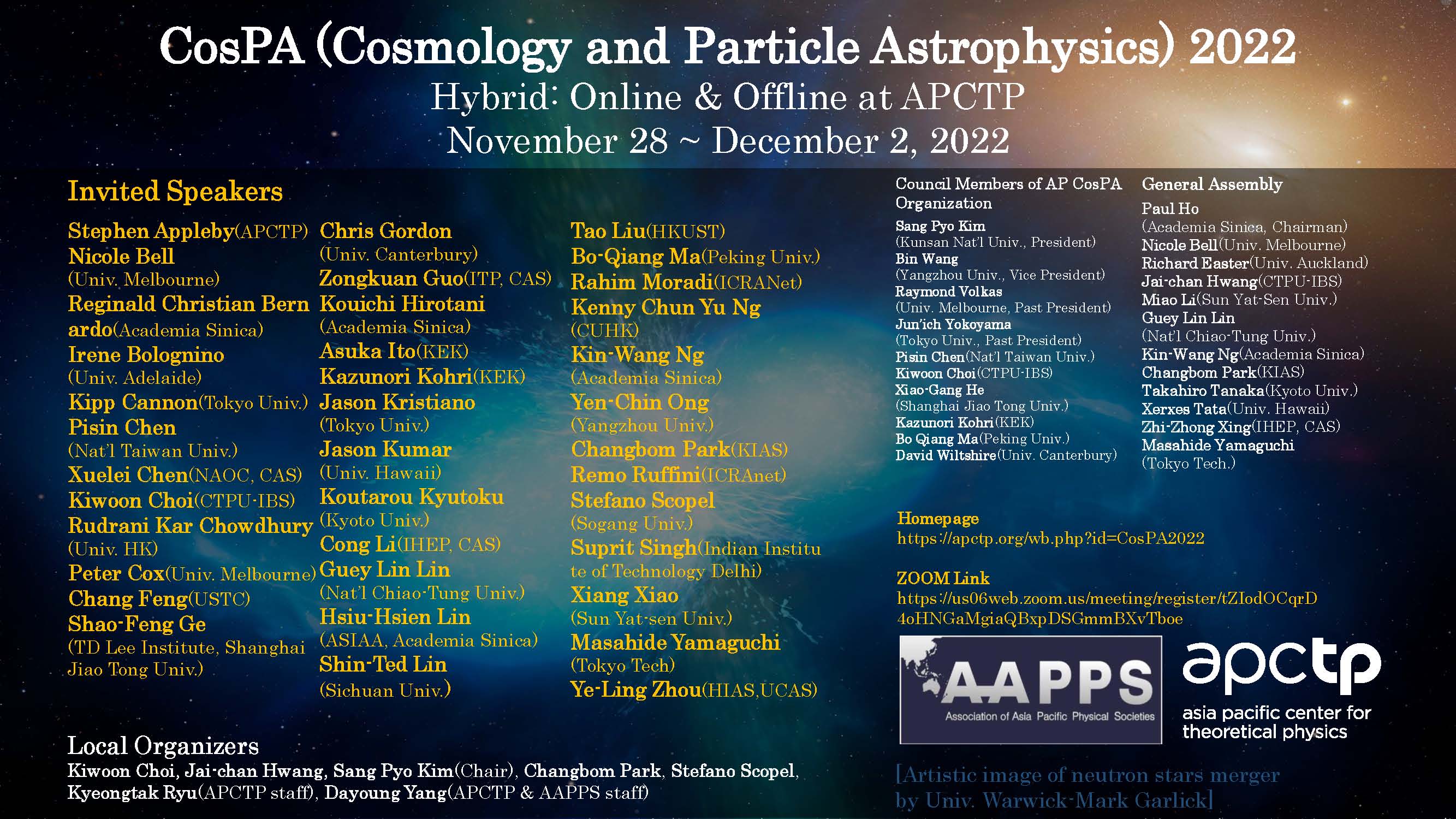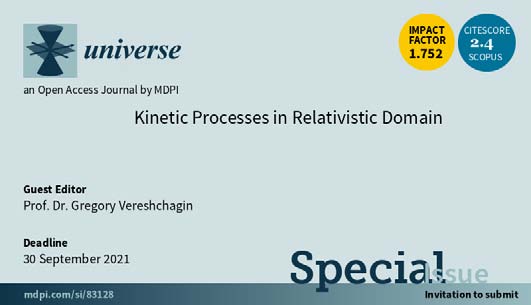

| Newsletter Russian December/January 2023 |

|

|



ICRANet Newsletter
2014 -
2015 -
2016
2017 - 2018 - 2019 2020 - 2021 2022 February/March - April/May/June - July/August/September - October/November - December/January 2023 2023
Новостная рассылка ICRANet
декабрь 2022 г. - январь 2023 г.
РЕЗЮМЕ
1. Научные достижения: Н. Саакян, П. Джомми, П. Падовани, М. Петропулу, Д. Беге, Б. Боккарди, С. Гаспарян, Мультиинформационное исследование блазара PKS 0735+178: новый кандидат в крупные источники нейтрино, ежемесячные уведомления Королевского астрономического общества, том 519, выпуск 1 2. Публикация электронных материалов MG16, 25 января 2023 г. 3. Участие ICRANet в Международном симпозиуме по космологии и астрофизике частиц в 2022 г. ( CosPA 2022), 27 ноября - 2 декабря 2022 г., APCTP (Южная Корея), онлайн 4. 2-ая встреча лидеров итальянских знаний, 5 декабря 2022 г., Милан (Италия) 5. Профессор Рахим Моради награжден премией Лучио Коллетти, 7 декабря 2022 г., Рим (Италия) 6. Спецвыпуск издания Вселенная «Кинетические процессы в релятивистской области» под редакцией проф. Григория Верещагина 7. Научные визиты ICRANet 8. Последние публикации
1. Научные достижения: Н. Саакян, П. Джомми, П. Падовани, М. Петропулу, Д. Беге, Б. Боккарди, С. Гаспарян, Мультиинформационное исследование блазара PKS 0735+178: кандидат на новый крупный источник нейтрино, Ежемесячные уведомления Королевского астрономического общества, том 519, выпуск 1
Блазар PKS 0735+178, возможно, связан с множественными нейтринными событиями, наблюдаемыми нейтринными телескопами IceCube, Baikal, Baksan и KM3NeT. Это замечательное сочетание событий и многоволнового охвата делает PKS 0735+178 одним из лучших кандидатов на источники нейтрино, обнаруженных до сих пор. Свойства мультимессенджера PKS 0735+178 были изучены в недавней статье, опубликованной в Ежемесячных уведомлениях Королевского астрономического общества, в соавторстве с Н. Саакяном, П. Джомми, П. Падовани, М. Петропулу, Д. Беге, Б. Боккарди и С. Гаспарян.
Открытие потока нейтрино очень высоких энергий (VHE; > 100 ГэВ) астрофизического происхождения обсерваторией Южного полюса IceCube и первая достоверная ассоциация нейтрино IceCube с космическим источником, блазарами TXS 0506+056, проложили путь за начало (внегалактической) нейтринной астрономии. Недавно было обнаружено несколько других возможных ассоциаций между нейтрино IceCube и блазарами, что усилило связь между нейтрино VHE и блазарами на разных уровнях значимости. Блазары, редкий тип мощных активных галактических ядер (АЯГ) с релятивистской струей, направленной на Землю, известны как эффективные и мощные космические ускорители, и по этой причине уже давно считаются потенциальными источниками астрофизических нейтрино.
На рисунке 1 показана многоволновая кривая блеска PKS 0735+178 с 2008 по 2022 год, а на рисунке 2 показана составная многочастотная кривая блеска во время прихода нейтрино. Поток во всех полосах ведет себя одинаково, при этом самая большая вспышка с момента запуска спутника Ферми в 2008 г. пришлась на момент IceCube-211208A, отмеченный на рисунке красной вертикальной пунктирной линией. Во время прибытия нейтрино IceCube-211208A в PKS 0735+178 наблюдалась самая большая вспышка в 𝛾 -излучении, рентгеновском и оптическом диапазонах, наблюдаемая с 2008 года. Это еще больше усиливает возможную связь между PKS 0735+178 и IceCube-211208A. и PKS 0735+178 следует считать одним из лучших кандидатов на источник нейтрино СВЭ, обнаруженных до сих пор.
Благодаря очень хорошему многоволновому охвату от оптического до высокочастотного диапазона во время события IceCube-211208A, доступный набор данных очень ограничен, что позволяет выполнить всестороннее моделирование многоволнового излучения от PKS 0735+178. В частности, спектральное распределение энергии PKS 0735+178 было смоделировано в рамках однозонных лепто -адронных моделей с учетом как внутренних, так и внешних фотонных полей и оценен ожидаемый поток сопутствующих нейтрино. Код SOPRANO использовался для моделирования электромагнитного и нейтринного излучения PKS0735+178. Код был разработан для изучения зависящего от времени излучения 𝛾 -излучения и нейтрино от релятивистских источников, таких как блазары и гамма-всплески, с учетом всех соответствующих радиационных процессов. Наиболее оптимистичный сценарий предполагает наличие джета со светимостью, близкой к эддингтоновской, и взаимодействие ∼ Протоны ПэВ с внешним УФ фотонным полем. Широкополосный SED PKS 0735+178 во время прибытия IceCube-211208A, смоделированный с учетом наличия поля внешнего излучения (фотоны области широких линий), показан на рисунке 3. Этот сценарий предсказывает ∼ 0,067 мюонных и антимюонных нейтрино над наблюдаемым 3-недельная вспышка. Полученные результаты согласуются с обнаружением одного нейтрино очень высокой энергии, такого как IceCube-211208A.
2. Публикация электронных материалов MG16, 25 января 2023 г.

Мы с большим удовольствием сообщаем вам, что материалы заседания MG16, проходившего в режиме онлайн с 5 по 10 июля 2021 года, были только что опубликованы World Scientific в качестве документа с открытым доступом. Вот ссылка на 4 тома (A, B, C и D) на специальной странице веб-сайта World Scientific: www.worldscientific.com/worldscibooks/10.1142/13149
Эти труды включают около 400 статей, в результате чего 4880 страниц печатных томов охватывают практически все темы астрофизики, гравитации и космологии, традиционно обсуждаемые на заседаниях МГ.
Напомним, что MG16 стала рекордной встречей, в которой приняли участие более 1200 участников из более чем 50 стран. Редакторы сборника Ремо Руффини и Григорий Верещагин.
3. Участие ICRANet в Международном симпозиуме по космологии и астрофизике частиц в 2022 г. ( CosPA 2022), 27 ноября - 2 декабря 2022 г., APCTP (Южная Корея), онлайн
С 27 ноября по 2 декабря 2022 г. профессор Ремо Руффини (директор ICRANet) и профессор Рахим Моради (профессор факультета ICRANet) были приглашены прочитать лекцию по случаю Международного симпозиума по космологии и астрофизике элементарных частиц в 2022 г. ( CosPA 2022), проводимых как на APCTP (Южная Корея), так и онлайн.
CosPA — это серия конференций, инициированных на Тайване и ежегодно организуемых в Азиатско-Тихоокеанском регионе в рамках деятельности Азиатско-Тихоокеанской организации космологии и астрофизики элементарных частиц ( APCosPA ). Это издание состоялось после двухлетней отсрочки из-за распространяющейся пандемии Covid-19. Основными темами, затронутыми на конференции, были астрофизика, физика элементарных частиц, космология и гравитация.  В среду, 30 ноября, профессор Руффини представил лекцию под названием « Ассоциация GRB-сверхновая в рамках модели бинарной гиперновой». Ниже аннотация: Ассоциация сверхновых с гамма-всплесками была отмечена Beppo SAX и оптическим наблюдением SN1998bw, связанной с GRB980425. С самого начала проблема заключалась в том, чтобы столкнуться с различным концептуальным происхождением этих компонентов и их энергетики. Сегодня эта область была развита в бинарной гиперновой (модель BdHN) и стала самой обширной темой в релятивистской астрофизике. Роль ядра CO-прародителя и двойной нейтронной звезды недавно стала центральной в развитии модели BdHN. В этой работе подробно описаны семейства BdHN I, BdHN II и BdHN III, а также роль сверхновой, новорожденной нейтронной звезды и спутника НЗ (ЧД в BdHN I). В четверг, 1 декабря, профессор Рахим Моради представил лекцию под названием «GRB 221009A: BdHN типа I исключительной энергетики » . Ниже аннотация: GRB 221009A, самый интенсивный и плавный гамма-всплеск, обнаруженный Fermi GBM, предоставляет редкую возможность протестировать различные модели гамма-всплесков. В этом исследовании мы изучаем характеристики GRB 221009A с использованием модели Binary Driven Hypernova (BdHN). GRB221009A, классифицируемый как BdHN типа I, возникает в результате коллапса углеродно-кислородного ядра (CO-ядра) в присутствии нейтронной звезды-компаньона (NS). В этом исследовании мы сначала изучаем характеристики внутреннего двигателя этого гамма-всплеска, который питает ГэВ-излучение, наблюдаемое Fermi-LAT. Мы также показываем, что рентгеновское послесвечение питается от высвобождения энергии вращения новорожденной нейтронной звезды, развивающейся как сфероид Маклорена, начиная с точки бифуркации эллипсоида Якоби. Для веб-сайта встречи: indicocquest.sogang.ac.kr/event/19/
4. 2-ая встреча лидеров итальянских знаний, Милан (Италия), 5 декабря 2022 г.
5 декабря 2022 г. профессор Ремо Руффини, директор ICRANet, был приглашен принять участие во 2-й встрече итальянских лидеров знаний в качестве одного из награжденных итальянских лидеров знаний.

Этот проект, организованный под эгидой Министерства туризма Италии, был направлен на то, чтобы начать путь, который объединяет поддержку итальянских учреждений и фирм, а также научные и культурные компетенции наиболее важных «лидеров знаний» нашей страны. На этой встрече присутствовали соответствующие представители национальных и местных институтов, а также делегация основных «лидеров итальянских знаний», видных представителей международных научных и профессиональных институтов. Это второе мероприятие из серии встреч, которые послужат хорошей возможностью для организации сетевых мероприятий, учебных курсов и конференций, направленных на повышение осведомленности о научном и культурном развитии на национальном и международном уровне. Основная цель проекта – дать должное признание этим «интеллектуальным лидерам» как послам итальянского интеллектуального капитала, вовлечь их в продвижение Италии как «направления знаний» и побудить лидеров мнений быть еще более активными. на международном уровне, в целях продвижения научных и культурных знаний нашей страны.
5. Профессор Рахим Моради награжден премией Лучио Коллетти, Рим (Италия), 7 декабря 2022 г.
Мы рады сообщить, что 7 декабря 2022 года профессор Рахим Моради, профессор факультета ICRANet, был награжден премией « Лучио Коллетти » Лучио Фонд Коллетти . Церемония прошла в зале « Сала» . Laudatosì Сенаторского дворца в Камипольо, резиденции муниципалитета Рима.
В выпуске 2022 года премия также была присуждена Марко Тарадашу (политик), Лоренцо Инфантино (философ), Дианоре Тинти (писатель), Алессандре Джованнони (художник), Джованне Боттери (журналист), Гизельде Ваньони (журналист), Валерио Росси Альбертини ( физик), Сильвио Перрелла (писатель) и Антонио Бонфилио (музыковед). Профессор Моради был очень признателен за столь важное признание своих исследований и поблагодарил всю организацию за их доброту и внимание.
6. Спецвыпуск Вселенная «Кинетические процессы в релятивистской области» под редакцией проф. Григория Верещагина

Журнал Universe опубликовал в 2022 году специальный выпуск под названием «Кинетические процессы в релятивистской области» под редакцией профессора Григория Верещагина (профессора факультета ICRANet). Цель этого специального выпуска — осветить последние достижения в кинетической теории, уделив особое внимание релятивистской плазме, переносу нейтрино, самогравитирующим системам и темной материи, переносу излучения в релятивистских потоках и другим новым и возникающим темам в кинетической теории. Вклад в этот вопрос включает:
Все статьи опубликованы в формате открытого доступа и могут быть загружены с сайта Universe: www.mdpi.com/journal/universe/special_issues/KPRD
7. Научные визиты ICRANet
• Николай Прокопения (ICRANet-Минск и БГУ), 5 – 16 декабря 2022 г.
• Шуруй Чжан (Университет науки и технологий Китая), 15 декабря 2022 г. - продолжается • Проф. Сейед Мохаммад Таги Миртораби (Университет Альзахра - Иран), 26 января 2023 г. - продолжается Во время своего визита эти ученые имели возможность обсудить свои научные исследования и провести плодотворный обмен идеями с другими исследователями из ICRANet и из разных уголков мира.
8. Последние публикации
Shesheng Xue, Massive particle pair production and oscillation in Friedman Universe: its effect on inflation, to be published in The European Physical Journal C.
We study the classical Friedman equations for the time-varying cosmological term Λ~ and Hubble function H, together with quantised field equations for the production of massive M≫H particles, namely, the Λ~CDM scenario of dark energy and matter interactions. Classical slow components O(H−1) are separated from quantum fast components O(M−1). The former obeys the Friedman equations, and the latter obeys a set of nonlinear differential equations. Numerically solving equations for quantum fast components, we find the production and oscillation of massive particle-antiparticle pairs in microscopic time scale O(M−1). Their density and pressure averages over microscopic time do not vanish. It implies the formation of a massive pair plasma state in macroscopic time scale O(H−1), whose effective density and pressure contribute to the Friedman equations. Considering the inflation driven by the time-varying cosmological term and slowed down by the massive pair plasma state, we obtain the relation of spectral index and tensor-to-scalar ratio in agreement with recent observations. We discuss the singularity-free pre-inflation, the CMB large-scale anomaly, and dark-matter density perturbations imprinting on power spectra.
DOI: https://doi.org/10.1140/epjc/s10052-023-11195-6 M. F. Sousa, J. G. Coelho, J. C. N. de Araujo, S. O. Kepler and J. A. Rueda, The Double White Dwarf Merger Progenitors of SDSS J2211+1136 and ZTF J1901+1458, published on December 9, 2022 in The Astrophysical Journal, Volume 941, Number 1.
Double white dwarf (DWD) mergers are possibly the leading formation channel of massive, rapidly rotating, high-field magnetic white dwarfs (HFMWDs). However, a direct link connecting a DWD merger to any observed HFMWD is still missing. We here show that the HFMWDs SDSS J221141.80+113604.4 (hereafter J2211+1136) and ZTF J190132.9+145808.7 (hereafter J1901+1458) might be DWD merger products. J2211+1136 is a 1.27 M⊙ white dwarf (WD) with a rotation period of 70.32 s and a surface magnetic field of 15 MG. J1901+1458 is a 1.327–1.365 M⊙ WD with a rotation period of 416.20 s, and a surface magnetic field in the range 600–900 MG. With the assumption of single-star evolution and the currently measured WD masses and surface temperatures, the cooling ages of J2211+1136 and J1901+1458 are, respectively, 2.61–2.85 Gyr and 10–100 Myr. We hypothesize that these WDs are DWD merger products and compute the evolution of the postmerged configuration formed by a central WD surrounded by a disk. We show that the postmerger system evolves through three phases depending on whether accretion, mass ejection (propeller), or magnetic braking dominates the torque onto the central WD. We calculate the time the WD spends in each of these phases and obtain the accretion rate and disk mass for which the WD rotational age, i.e., the total time elapsed since the merger to the instant where the WD central remnant reaches the current measured rotation period, agrees with the estimated WD cooling age. We infer the mass values of the primary and secondary WD components of the DWD merger that lead to a postmerger evolution consistent with the observations.
DOI: https://doi.org/10.3847/1538-4357/aca015 Liang Li, Standard GRB Spectral Models "Misused"?, published on December 9, 2022 in the Astrophysical Journal, Volume 941, Number 1.
The standard model characterizing the gamma-ray burst (GRB) spectrum invokes a four-parameter empirical function, the so-called the BAND model. An alternative model named cutoff power law (COMP) implements a power law with an exponential cutoff. These functions achieve almost equally good fits on observed spectra, and are adopted in nearly all of the GRB literature. Here, we reanalyze the sample defined in Li et al. (39 bursts including 944 spectra). We classify the spectra by two methods: (1) checking their corner–corner plots of the posteriors to determine well-constrained β (BAND-better) and unconstrained β (COMP-better) categories; and (2) defining the four groups by difference of the deviance information criterion (DIC). We find inconsistent peaks of the parameter distributions between the BAND-better spectra (α = −0.64 ± 0.28 and log10 (Ep) = log10 (191) ± 0.41) and the COMP-better spectra (α = −0.96 ± 0.33 and log10 (Ep) = log10 (249) ± 0.40). With the statistically preferred model and vice versa the misused model defined based on DIC statistics, we also find that the fitted parameters obtained by the misused model (COMP) significantly deviate from those obtained by the statistically preferred model (BAND). This means that if a spectrum is statistically preferred, described as the BAND, applying COMP to derive the spectral parameters will prominently deviate from their intrinsic shape, therefore affecting the physical interpretation. Our analysis indicates that the better or statistically preferred model should be duly examined during GRB spectral analysis. In addition, the β distribution exhibits a bimodal structure containing the BAND-better and COMP-better spectra, respectively, implying that BAND and COMP both may have physical origin.
DOI: https://doi.org/10.3847/1538-4357/ac3d89 N. Sahakyan, P. Giommi, P. Padovani, M. Petropoulou, D. Bégué, B. Boccardi, S. Gasparyan, A multimessenger study of the blazar PKS 0735+178: a new major neutrino source candidate, Monthly Notices of the Royal Astronomical Society, Volume 519, Issue 1.
The blazar PKS 0735+178 is possibly associated with multiple neutrino events observed by the IceCube, Baikal, Baksan, and KM3NeT neutrino telescopes while it was flaring in the γ-ray, X-ray, ultraviolet, and optical bands. We present a detailed study of this peculiar blazar to investigate the temporal and spectral changes in the multiwavelength emission when the neutrino events were observed. The analysis of Swift-XRT snapshots reveal a flux variability of more than a factor 2 in about 5 × 103 s during the observation on 2021 December 17. In the γ-ray band, the source was in its historical highest flux level at the time of the arrival of the neutrinos. The observational comparison between PKS 0735+178 and other neutrino source candidates, such as TXS 0506+056, PKS 1424+240, and GB6 J1542+6129, shows that all these sources share similar spectral energy distributions, very high radio and γ-ray powers, and parsec scale jet properties. Moreover, we present strong supporting evidence for PKS 0735+178 to be, like all the others, a masquerading BL Lac. We perform comprehensive modelling of the multiwavelength emission from PKS 0735+178 within one-zone lepto-hadronic models considering both internal and external photon fields and estimate the expected accompanying neutrino flux. The most optimistic scenario invokes a jet with luminosity close to the Eddington value and the interactions of ∼PeV protons with an external UV photon field. This scenario predicts ∼0.067 muon and anti-muon neutrinos over the observed 3-week flare. Our results are consistent with the detection of one very high-energy neutrino like IceCube-211208A.
DOI: https://doi.org/10.1093/mnras/stac3607 N. Sahakyan, V. Vardanyan, M. Khachatryan, Gradient boosting decision trees classification of blazars of uncertain type in the fourth Fermi-LAT catalogue, to be published on Monthly Notices of the Royal Astronomical Society, Volume 519, Issue 2.The deepest all-sky survey available in the γ-ray band – the last release of the Fermi-LAT catalogue (4FGL-DR3) based on the data accumulated in 12 years contains more than 6600 sources. The largest population among the sources is blazar subclass – 3743, 60.1 per cent of which are classified as BL Lacertae objects (BL Lacs) or Flat Spectrum Radio Quasars (FSRQs), while the rest are listed as blazar candidates of uncertain type (BCU) as their firm optical classification is lacking. The goal of this study is to classify BCUs using different machine learning algorithms, which are trained on the spectral and temporal properties of already classified BL Lacs and FSRQs. Artificial Neural Networks, XGBOOST, and LIGHTGBM algorithms are employed to construct predictive models for BCU classification. Using 18 input parameters of 2219 BL Lacs and FSRQs, we train (80 per cent of the sample) and test (20 per cent) these algorithms and find that LIGHTGBM model, state-of-the-art classification algorithm based on gradient boosting decision trees, provides the highest performance. Based on our best model, we classify 825 BCUs as BL Lac candidates and 405 as FSRQ candidates, however, 190 remain without a clear prediction, but the percentage of BCUs in 4FGL is reduced to 5.1 per cent. The γ-ray photon index, synchrotron peak frequency, and high-energy peak frequency of a large sample are used to investigate the relationship between FSRQs and BL Lacs (LBLs, IBLs, and HBLs).DOI: https://doi.org/10.1093/mnras/stac3701 MAGIC collaboration, Gamma-ray observations of MAXI J1820+070 during the 2018 outburst, published on December 2022 in Monthly Notices of the Royal Astronomical Society, Volume 517, Issue 4.MAXI J1820+070 is a low-mass X-ray binary with a black hole (BH) as a compact object. This binary underwent an exceptionally bright X-ray outburst from 2018 March to October, showing evidence of a non-thermal particle population through its radio emission during this whole period. The combined results of 59.5 h of observations of the MAXI J1820+070 outburst with the H.E.S.S., MAGIC and VERITAS experiments at energies above 200 GeV are presented, together with Fermi-LAT data between 0.1 and 500 GeV, and multiwavelength observations from radio to X-rays. Gamma-ray emission is not detected from MAXI J1820+070, but the obtained upper limits and the multiwavelength data allow us to put meaningful constraints on the source properties under reasonable assumptions regarding the non-thermal particle population and the jet synchrotron spectrum. In particular, it is possible to show that, if a high-energy (HE) gamma-ray emitting region is present during the hard state of the source, its predicted flux should be at most a factor of 20 below the obtained Fermi-LAT upper limits, and closer to them for magnetic fields significantly below equipartition. During the state transitions, under the plausible assumption that electrons are accelerated up to ∼500 GeV, the multiwavelength data and the gamma-ray upper limits lead consistently to the conclusion that a potential HE and very-HE gamma-ray emitting region should be located at a distance from the BH ranging between 1011 and 1013 cm. Similar outbursts from low-mass X-ray binaries might be detectable in the near future with upcoming instruments such as CTA.DOI: https://doi.org/10.1093/mnras/stac2686 MAGIC collaboration, Search for Gamma-ray Spectral Lines from Dark Matter Annihilation up to 100 TeV towards the Galactic Center with MAGIC, accepted for publication in Phys. Rev. Letters.Line-like features in TeV γ-rays constitute a ''smoking gun'' for TeV-scale particle dark matter and new physics. Probing the Galactic Center region with ground-based Cherenkov telescopes enables the search for TeV spectral features in immediate association with a dense dark matter reservoir at a sensitivity out of reach for satellite γ-ray detectors, and direct detection and collider experiments. We report on 223 hours of observations of the Galactic Center region with the MAGIC stereoscopic telescope system reaching γ-ray energies up to 100 TeV. We improved the sensitivity to spectral lines at high energies using large-zenith-angle observations and a novel background modeling method within a maximum-likelihood analysis in the energy domain. No line-like spectral feature is found in our analysis. Therefore, we constrain the cross section for dark matter annihilation into two photons to ⟨σv⟩ ≲ 5×10−28cm3s−1 at 1 TeV and ⟨σv⟩ ≲ 1×10−25cm3s−1 at 100 TeV, achieving the best limits to date for a dark matter mass above 20 TeV and a cuspy dark matter profile at the Galactic Center. Finally, we use the derived limits for both cuspy and cored dark matter profiles to constrain supersymmetric wino models.DOI: https://doi.org/10.48550/arXiv.2212.10527 S. H. Hendi, Kh. Jafarzade, and B. EslamPanah, Black holes in dRGT massive gravity with the signature of EHT observations of M87*, accepted for publication in Journal of Cosmology and Astroparticle Physics.The recent Event Horizon Telescope (EHT) observations of the M87* have led to a surge of interest in studying the shadow of black holes. Besides, investigation of time evolution and lifetime of black holes helps us to veto/restrict some theoretical models in gravitating systems. Motivated by such exciting properties, we study optical features of black holes, such as the shadow geometrical shape and the energy emission rate in modified gravity. We consider a charged AdS black hole in dRGT massive gravity and look for criteria to restrict the free parameters of the theory. The main goal of this paper is to compare the shadow of the mentioned black hole in a rotating case with the EHT data to obtain the allowed regions of the model parameters. Therefore, we employ the Newman-Janis algorithm to build the rotating counterpart of static solution in dRGT massive gravity. We also calculate the energy emission rate for the rotating case and discuss how the rotation factor and other parameters affect the emission of particles around the black holes. |
|||||||||
|
||






